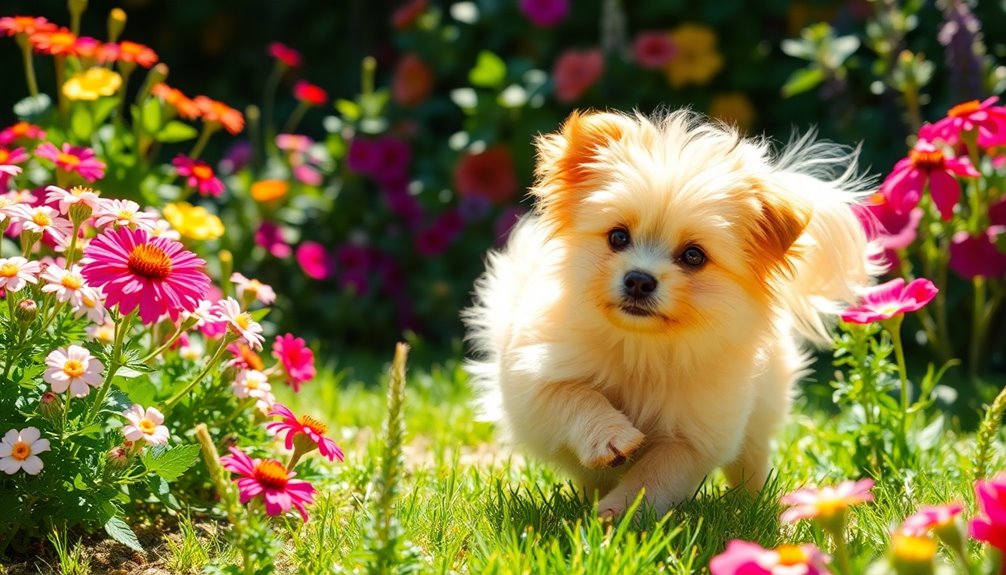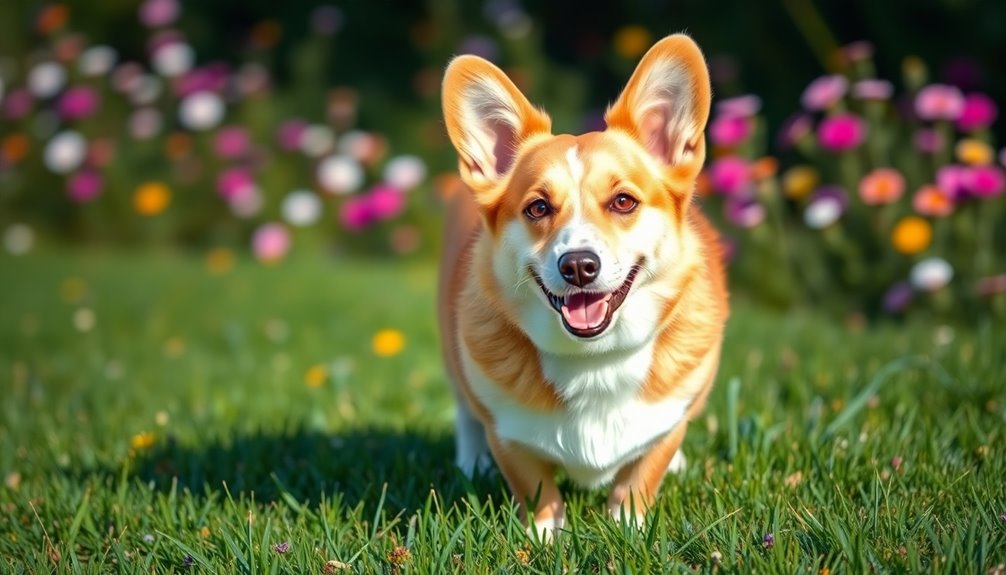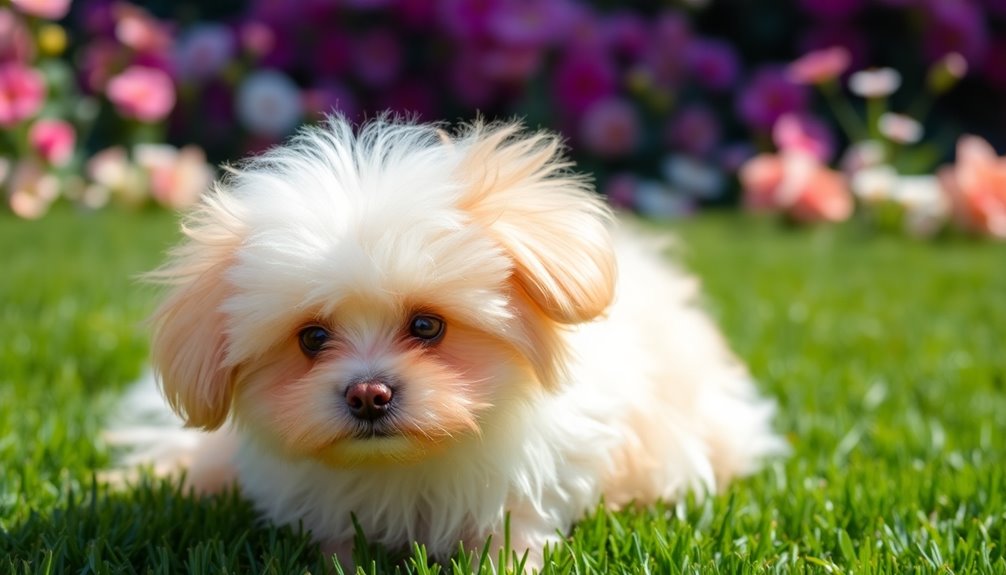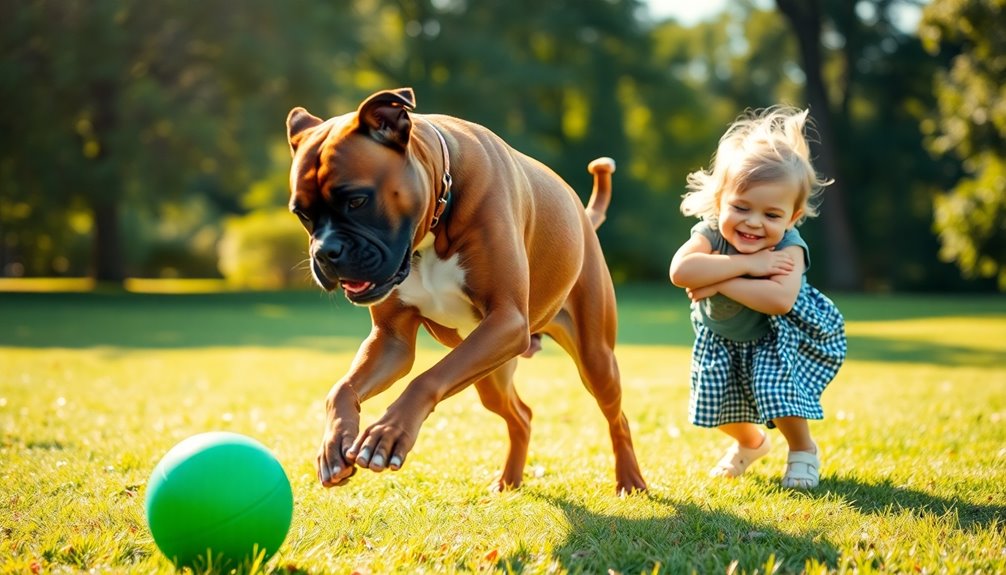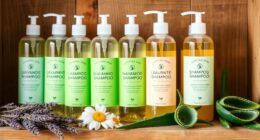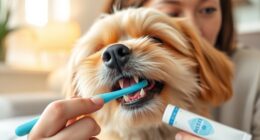The Peek-A-Poo, a charming mix of Pekingese and Poodle, is sure to steal your heart. These affectionate companions are small, typically weighing between 4 to 20 pounds and standing up to 12 inches tall. Known for their playful nature and hypoallergenic coats, they make ideal pets for families, especially those with older kids. Their grooming needs are manageable with regular brushing and occasional professional cuts. Peek-A-Poos thrive in apartments and enjoy short walks and indoor playtime. If you find yourself intrigued, there's more to discover about their delightful personality and care requirements.
Key Takeaways
- Peekapoos are affectionate and playful companions, combining the charm of Pekingese and Poodles in a small, hypoallergenic package.
- They thrive in apartment living, requiring minimal exercise through short walks and indoor playtime.
- Regular grooming is vital for their coat health, with daily brushing recommended for long coats to prevent matting.
- Peekapoos bond closely with families, making them great companions for older children, but need supervision around younger kids.
- Their lifespan ranges from 10 to 15 years, with proper care significantly impacting their health and longevity.
Introduction
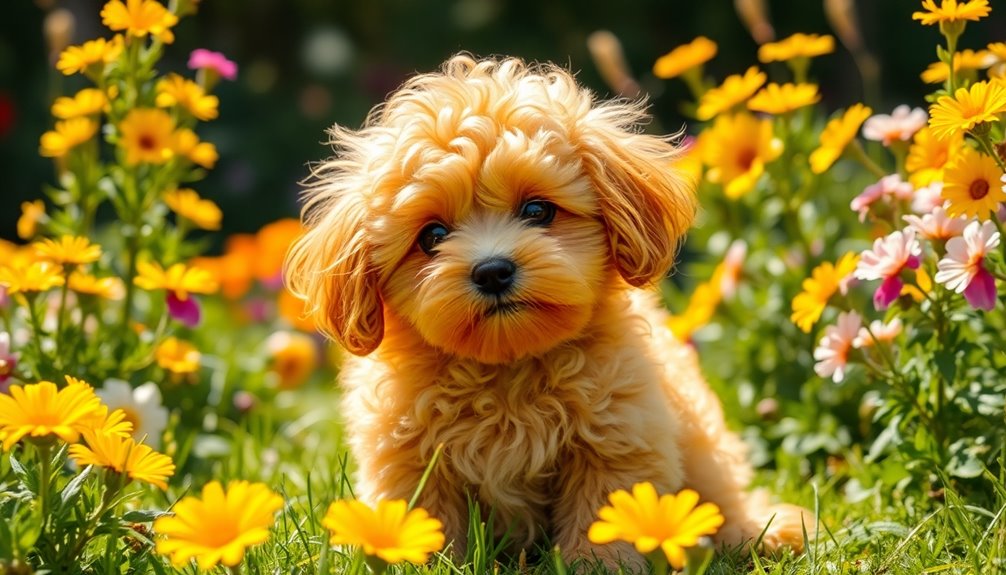
If you're considering adding a Pekingese and Poodle mix, known as a Peekapoo, to your family, you're in for a delightful experience.
These charming little dogs blend the best traits of both breeds, making them perfect companions for families and individuals alike. They come in two sizes—Mini and Toy—ranging from about 10 to 12 inches tall, and weighing between 4 to 20 pounds.
Peekapoos are known for their unique coats, which can vary from curly to slightly wavy or straight, resulting in a variety of colors inherited from both parent breeds. Their affectionate nature makes them loving companions, while their loyal disposition adds a layer of devotion to your household.
Friendly and outgoing, these pups bring joy to everyone they meet. With a manageable energy level, Peekapoos don't require extensive exercise, making them suitable for smaller spaces. Additionally, they are known for their intelligence and adaptability, making them suitable for various living situations.
Training them is usually straightforward, but it's essential to use consistent, positive reinforcement. They do require regular grooming to keep their coats healthy and tangle-free.
History and Origin
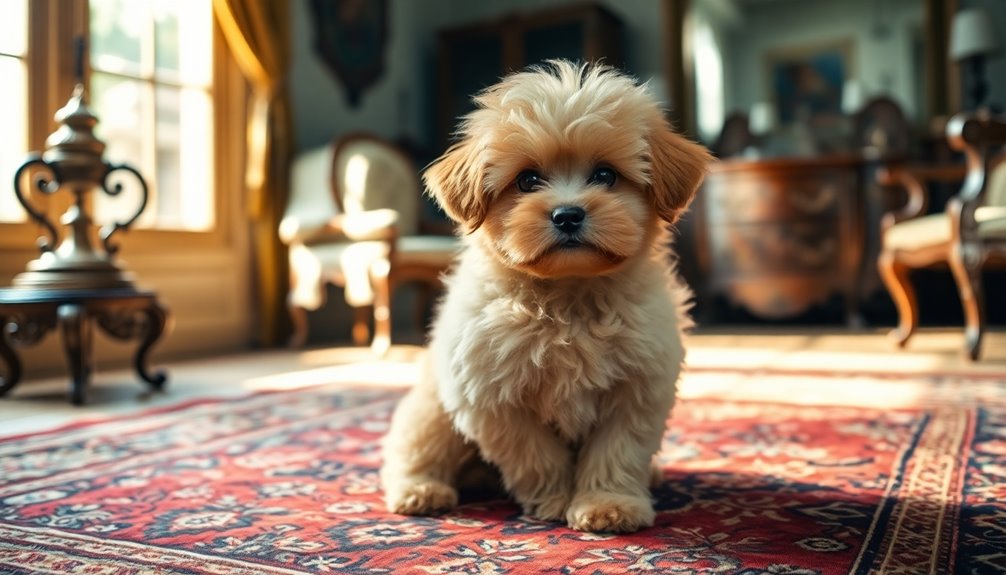
The Pekingese and Poodle mix, often called the Peekapoo, emerged in the United States during the 1950s and 1960s. This breed combines the royal companionship history of the Pekingese, favored by Chinese emperors, with the Poodle's charm and intelligence. The Peekapoo was specifically created to address allergies and asthma by providing a low-shedding dog option.
Where and when the breed originated
Emerging in the United States during the 1950s, the Peekapoo—a charming mix of Pekingese and Poodle—likely resulted from either accidental crossings or deliberate breeding efforts by Cockapoo enthusiasts.
While the exact origin of this delightful breed isn't definitively known, it's clear that its creation aimed to cater to the needs of people with allergies and asthma.
During the 1960s, the Peekapoo gained popularity in North America, celebrated for its hypoallergenic coat and playful companion qualities. This breed is especially ideal for allergy sufferers due to its low shedding characteristics.
As one of the oldest mixed breeds and among the first designer dogs, it quickly captured the hearts of dog lovers.
The Peekapoo's parent breeds add to its charm.
The Pekingese, with roots in ancient China, has a history spanning over 2,000 years, while Poodles, originating from the French and German border, were initially bred for water retrieval before becoming beloved companions.
This unique combination results in a low-shedding, hypoallergenic coat that many find appealing.
Despite not being recognized by the American Kennel Club, the Peekapoo remains cherished for its delightful disposition and adorable appearance.
Royal Companionship and Status
Pekingese dogs have long been revered as symbols of royalty and companionship, especially in ancient China, where they were bred to serve as close companions to emperors and nobles. Their sacred status in Chinese culture stemmed from legends suggesting they were miniature lions, shrunk by the Buddha, embodying strength and loyalty.
These little dogs even served as guard dogs, tucked into royal sleeves. With their regal demeanor, Pekingese carry themselves with a bold and sophisticated presence, reflecting their royal heritage. Their compact, lion-like appearance and reserved behavior make them both dignified and affectionate companions. In addition to their affectionate nature, they also possess guard dog qualities that enhance their protective instincts.
While they bond strongly with their owners, often forming an attachment to one person, they can be selective in their friendships with other dogs. After being presented to Queen Victoria by British troops in 1860, Pekingese gained international recognition.
Today, they make wonderful house pets, especially in loving families that avoid rough play. Despite their small size, they can act as effective watchdogs, vocalizing their concerns about intruders. To thrive in modern households, early socialization and positive reinforcement training are essential.
Physical Characteristics
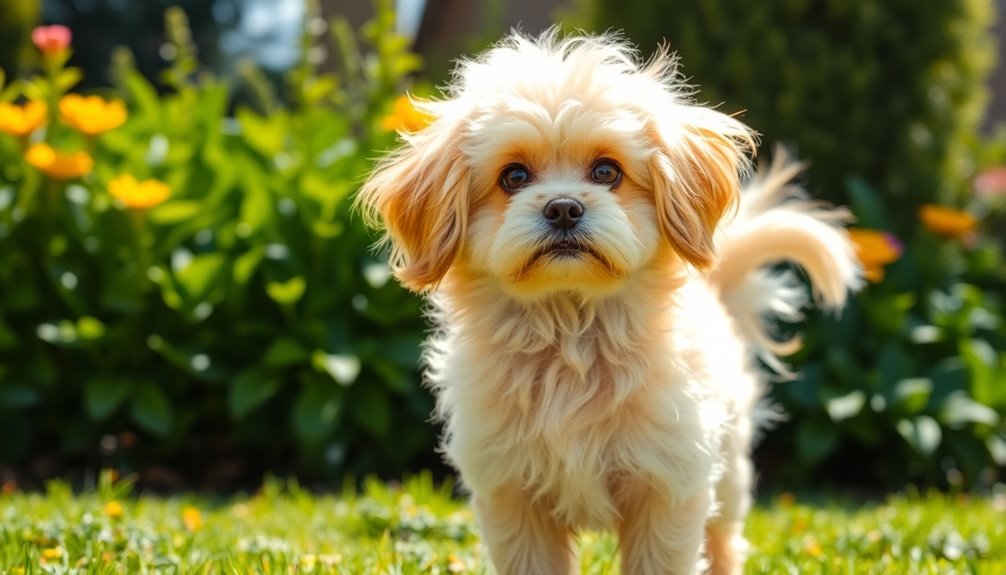
When you think about the Pekingese and Poodle mix, size and coat are key features to consider.
These dogs can weigh anywhere from 4 to 20 pounds and may have a soft, wavy coat that's hypoallergenic and requires regular grooming. Their small-sized breed status makes them an ideal choice for families living in apartments or smaller homes.
Their appearance can vary widely, showcasing a blend of both parent breeds, resulting in a unique look that's sure to catch your eye.
Size, weight, and coat details
With a delightful range in size and weight, the Pekingese and Poodle mix, or Peekapoo, typically weighs between 4 and 20 pounds and stands up to 11-12 inches tall at the shoulder.
You'll find that Mini Peekapoos usually weigh between 12-20 pounds and can reach up to 12 inches in height, while Toy or Teacup Peekapoos are smaller, weighing 4-12 pounds and standing up to 10 inches tall.
These pups reach their full-grown size by the time they're a year old, often achieving it by 7-12 months.
When predicting their adult weight, consider their weight at 15-18 weeks, as they typically reach about half their adult weight by 3.5-4 months. Puppy weight charts serve as general guidelines for estimating their growth and size.
Due to their hybrid nature, Peekapoos boast a diverse range of coat colors and patterns, including silver, grey, chocolate, black, white, cream, apricot, and buff.
You might see solid, bi-color, or multi-color coats, influenced by both parent breeds.
The unique combination of their Pekingese and Poodle heritage makes each Peekapoo an adorable individual with distinct physical characteristics.
Fluffy, Curly Coat Texture
The fluffy, curly coat of a Peekapoo is one of its most charming features, reflecting the unique blend of its Pekingese and Poodle lineage. Depending on its genetic makeup, you might find your Peekapoo sporting a curly, wavy, or even a straighter coat. Curly coats resemble the dense texture of Poodles, while wavy coats offer a lovely mix of both breeds. Straight coats, although less common, lean more towards the Pekingese.
Regardless of the texture, grooming is essential. If your Peekapoo has a long, natural coat, daily brushing is a must to prevent matting and tangles. A couple of times a week works for clipped coats. Using wire or pin brushes with rubber tips can make the process smoother. Be sure to have detangling sprays on hand for those curly or wavy locks. Additionally, their short muzzles can lead to breathing issues, highlighting the importance of regular grooming to ensure comfort.
Keep an eye out for mats, especially under the belly, as they can form quickly. Regular grooming keeps your pup's coat healthy and shiny. You might even consider professional grooming every 6-8 weeks, ensuring your Peekapoo always looks its best!
Temperament and Personality
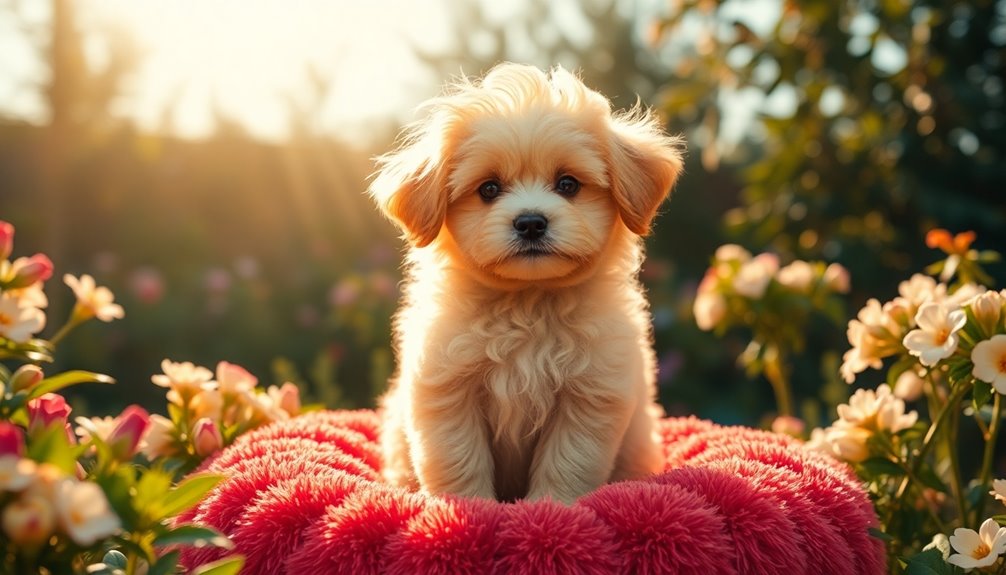
When you bring a Pekingese and Poodle mix into your home, you'll find that their playful and curious nature makes them a joy to be around. These dogs are well-suited for families, individuals, and even homes with other pets, as long as they're introduced properly. Their affectionate demeanor and loyalty will quickly win you over, making them wonderful companions. Additionally, their natural distrust of strangers makes them effective as guard dogs, adding an extra layer of protection to your home.
Playful and Curious Nature
Pekingese and Poodle mixes have a playful and curious nature that makes them delightful companions for families. They thrive on interaction and love to explore their environment, which keeps their spirits high and hearts full. These pups are energetic and require daily outdoor time, whether it's a brisk walk or a lively game of fetch. Their playful demeanor allows them to bond well with older children, making playtime enjoyable for everyone involved. While they've moderate exercise needs, you'll find their stubbornness can present challenges during training. However, with patience and consistent encouragement, they'll engage in activities that stimulate their minds and bodies. Their alertness means they stay tuned to their surroundings, ready to investigate any unusual sights or sounds. Despite their small size, their vigilant nature makes them effective watchdogs, always on the lookout for anything out of the ordinary. Just remember, early socialization helps them grow into well-rounded companions, as it supports overall development and growth. Their affectionate and loyal disposition means they'll always want to be by your side, making each day an adventure worth sharing.
Suitability for families, individuals, or other pets
Considering their affectionate and loyal nature, Pekingese and Poodle mixes make excellent companions for families, individuals, and other pets alike. They thrive in family environments, especially with older children who understand the need for gentle interaction.
While Peekapoos can form strong bonds with family members, it's essential to supervise their interactions with younger kids to avoid any rough handling that could lead to snapping.
For individuals, these little lap dogs are perfect companions. Their low-maintenance grooming and exercise needs make them suitable for busy lifestyles, and their hypoallergenic coats are a blessing for allergy sufferers. Additionally, their moderate exercise requirements mean that they can adapt well to apartment living, making them ideal for city dwellers.
Just remember, they can develop separation anxiety if left alone for extended periods.
When it comes to other pets, early socialization is crucial. Peekapoos usually get along well with small animals, especially if raised together, but caution is necessary around larger pets, as they can easily get injured.
By ensuring positive interactions and proper training, you can help your Peekapoo flourish in a multi-pet household.
Health and Lifespan
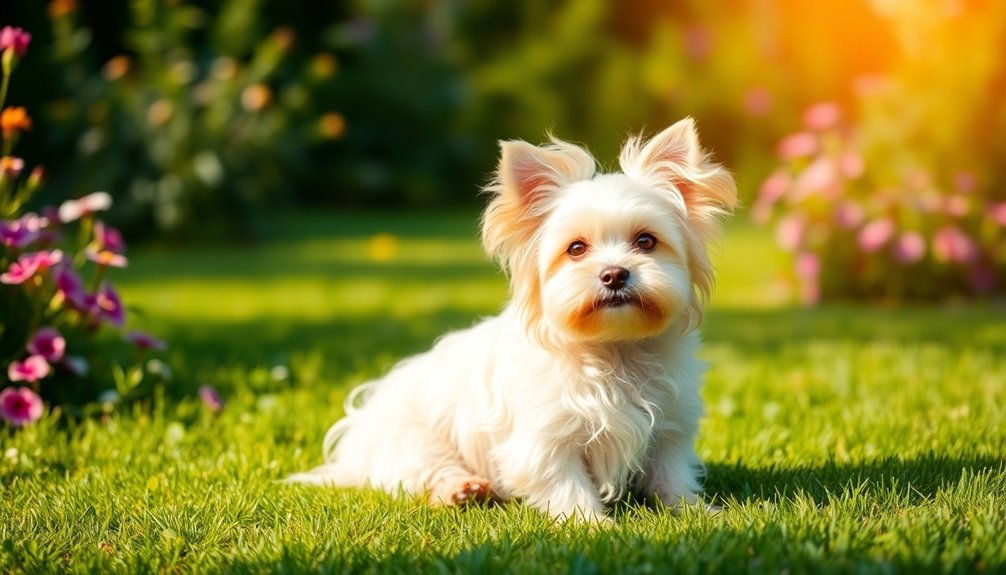
The typical lifespan of a Pekingese and Poodle mix ranges from 10 to 15 years, with proper care playing a crucial role in their longevity. However, they can be prone to specific health concerns like brachycephalic airway syndrome and patellar luxation. To keep your furry friend healthy, regular exercise and routine veterinary check-ups are essential. Additionally, common health issues include collapsing trachea and progressive retinal atrophy, which require vigilance in monitoring their health.
Typical lifespan of the breed
When it comes to the typical lifespan of a Pekingese and Poodle mix, you can expect them to live between 10 to 15 years, a range that reflects the lifespans of their parent breeds. This longevity can be influenced by a variety of factors, including genetics, quality of care, and lifestyle choices.
Providing your Peek-A-Poo with proper care, such as a balanced diet and regular health check-ups, can help extend their life. A high-quality kibble along with occasional treats will keep them healthy, while moderate exercise helps maintain their physical condition. Additionally, maintaining a high-energy routine is essential as these dogs require significant mental and physical stimulation.
Grooming also plays a crucial role; regular brushing and hygiene practices can prevent health issues. The environment they live in, along with socialization, can impact their overall well-being as well.
Individual lifespans can vary, with some dogs living up to 14 years or more depending on their breeding and lineage. Early health screenings and consistent veterinary care significantly contribute to a longer life.
Common health concerns or genetic predispositions
Health concerns for a Pekingese and Poodle mix, often referred to as Peek-A-Poo, can stem from both parent breeds, making it essential to be aware of potential genetic predispositions.
From the Pekingese side, you might encounter brachycephalic syndrome, which can lead to respiratory distress. They're also prone to cataracts, cleft palate, and heat exhaustion due to their facial structure. Male Peek-A-Poos may face issues like cryptorchidism, where testicles don't descend.
On the Poodle side, watch for patellar luxation, which can cause pain and mobility issues. Progressive retinal atrophy (PRA) might also affect their vision, and von Willebrand's disease could pose bleeding risks. Additionally, skin conditions like sebaceous adenitis are possible. Regular exercise is important to maintain their overall health and can help mitigate some of these health issues.
Orthopedic issues, including Legg-Calve-Perthes disease and hip dysplasia, can affect their quality of life.
You should also be alert for eye problems such as distichiasis and entropion, as well as dental diseases stemming from overcrowded teeth. Being proactive about these concerns can help ensure a healthier and happier life for your Peek-A-Poo.
Tips for maintaining health and wellness
To ensure your Peek-A-Poo thrives for years to come, focus on a balanced approach to diet, grooming, exercise, and regular health check-ups.
Start with high-quality food tailored to your dog's age and activity level, serving measured portions twice daily to prevent obesity. Consider dietary supplements with chondroitin and glucosamine to support joint health, and opt for fresh fruits and veggies—like blueberries, green beans, and carrots—as healthy treats in moderation. Providing interactive toys can also enhance your dog's mental stimulation and overall well-being.
Grooming is vital; brush your Peek-A-Poo weekly if they've a curly coat or daily for long, double coats to avoid matting. Additionally, professional grooming every 4-6 weeks is advisable to maintain their coat in optimal condition.
Don't forget to clean their ears regularly to prevent infections and trim their nails to avoid overgrowth.
Incorporate short walks and interactive playtime into your routine for both physical and mental stimulation. This not only aids in weight management but also promotes dental health.
Regular veterinary check-ups are essential to monitor overall health and catch any potential issues early.
With proper care, your Peek-A-Poo can live a happy, healthy life, typically ranging from 13 to 15 years.
Care Requirements
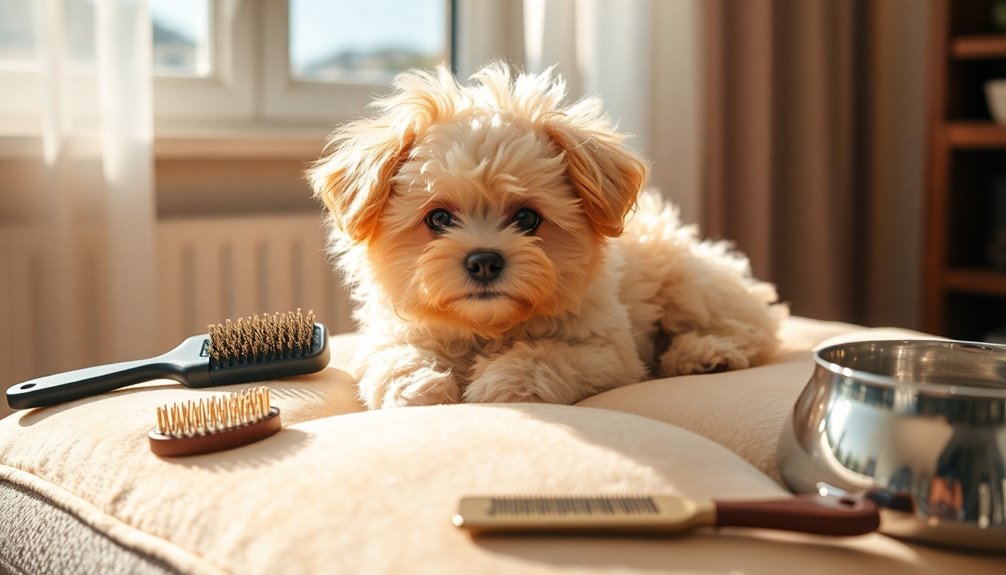
Caring for your Pekingese and Poodle mix means staying on top of regular brushing to keep their coat healthy and tangle-free. You'll also need to tailor their exercise routine to match their energy levels while ensuring they get the right nutrition through a balanced diet. Since Peekapoos are known for their hypoallergenic traits, it's beneficial to choose grooming products that cater to their unique coat needs. Additionally, providing them with high-quality protein sources in their diet can support their overall health.
Regular Brushing Required
Regular brushing is crucial for maintaining the coat of your Peekapoo, as it helps prevent knots, mats, and tangles. If you keep your Peekapoo's coat long, you'll need to brush it daily. For those clipped coats, brushing a couple of times a week is enough. Frequent brushing also helps distribute natural skin oils, ensuring your pup's coat stays shiny and healthy. Additionally, a Peekapoo's coat is soft and single-layered, making it essential to brush regularly to avoid matting.
Using the right tools is essential. A brush and comb work well for untangling stubborn mats before you clip. When trimming hair around the eyes, ears, and muzzle, opt for blunt-nosed scissors for safety. Regular grooming helps maintain a healthy coat and promotes scalp health, which is vital for your dog's overall well-being.
Electric clippers with snap-on guide combs are perfect for clipping body hair to your desired length, but avoid using human hair clippers, as they won't effectively cut through your Peekapoo's soft fur.
Keep in mind that the coat can vary, so grooming needs may differ. Daily brushing is particularly important around the face and rectum to prevent matting.
A well-groomed Peekapoo not only looks adorable but also feels comfortable, allowing you both to enjoy your time together.
Exercise requirements and energy levels
While your Peekapoo might be small, they still need a good amount of exercise to stay healthy and happy. Moderately paced walks and playtime are essential to maintain their physical and mental fitness. Daily activities can include leisurely strolls around the neighborhood or fun in the backyard. Additionally, incorporating activities that promote canine health can further enhance their well-being.
Don't forget that mental stimulation is just as important; using puzzle toys and interactive games can keep boredom at bay. It's also worth noting that the Peekapoo's hypoallergenic traits can benefit allergy sufferers, making them a great companion for families with sensitivities.
Despite their small size, Peekapoos are generally energetic, inheriting a playful instinct from their Poodle parent. Energetic puppies, in particular, benefit from extra playtime, while senior dogs may require less strenuous exercise.
Adjust your exercise routine based on your dog's age and energy levels.
Be mindful of environmental factors, too. Peekapoos can be sensitive to extreme temperatures, so on hot days, provide plenty of shade and water. In colder weather, a cozy sweater will keep them warm.
Always ensure they've a comfortable environment to prevent discomfort. By staying attentive to their exercise needs and energy levels, you can help your Peekapoo thrive.
Feeding tips and diet recommendations
Providing your Peekapoo with a balanced diet is crucial for their overall health and well-being. Start with high-quality kibble tailored for small breeds, as these formulas support their growth and energy needs. Look for premium brands that prioritize high-grade ingredients without fillers or low-protein content.
Incorporate protein from quality sources like chicken, lamb, or fish, while keeping fats in moderation. Omega-3 and omega-6 fatty acids are vital for their skin and coat health. You can occasionally add wet food, cooked lean meat, or vegetables, but do so sparingly to prevent obesity. Regular consultation with a veterinarian for dietary adjustments is also recommended to ensure optimal nutrition for your pet.
For adult Peekapoos, aim for ¼ to ¾ cups of kibble daily, divided into two meals. Puppies need more frequent feeding, about 3-4 meals until four months old, then transition to twice daily. Adjust their portions based on age, size, and activity level.
While a raw food diet can be beneficial, avoid grain-free kibble with high starchy carbs that could stress their digestive system.
Lastly, ensure they drink plenty of water, as hydration is essential for their overall health.
Training and Socialization
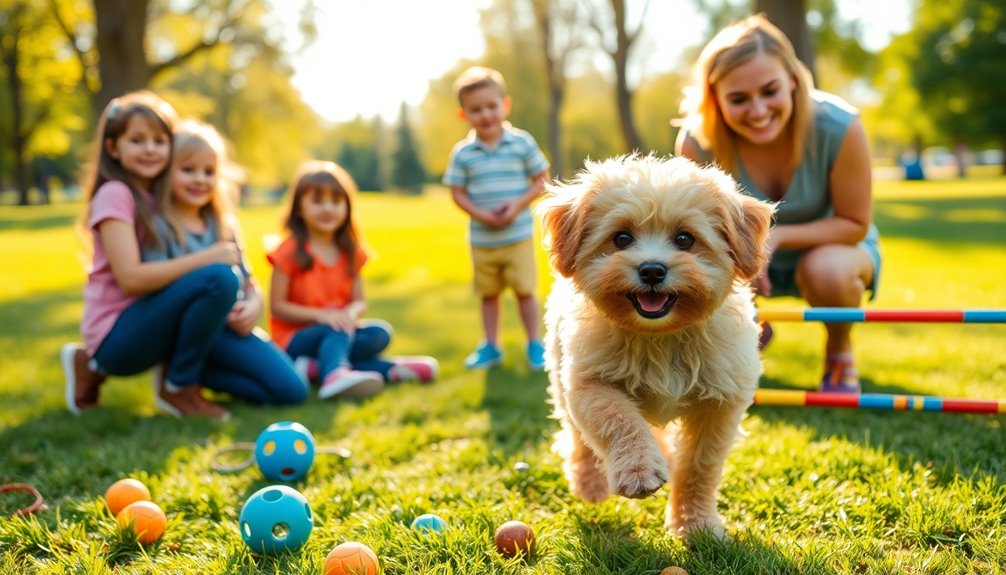
When training your Pekingese and Poodle mix, you'll notice they're moderately responsive to commands, so keep your sessions short and engaging. Gradual exposure to new environments is essential to help them feel secure and confident. Be mindful of separation anxiety, as it can affect their training progress, so always provide comfort and reassurance. Establishing a consistent walking routine can also greatly enhance their discipline and overall behavior.
Moderately Responsive to Commands
Training a Peekapoo involves a unique blend of patience and consistency, especially since they can be moderately responsive to commands. Start with basic commands like "sit" while your Peekapoo is still a puppy. Use a short leash to teach "heel," and once your dog masters "sit," move on to "stay." After they've got "stay" down, introduce the "come" command.
Consistency is crucial here; use the same command words and maintain a strict training schedule to create clarity. Avoid changing commands or hand signals frequently to prevent confusion. It's best to train in a consistent environment with minimal distractions. Make sure everyone in your household uses the same commands and techniques for uniformity.
Keep in mind that the Pekingese side of your Peekapoo can be stubborn. This requires you to be patient and persistent. Positive reinforcement, like treats and verbal praise, works wonders, but steer clear of shouting or negative reinforcement, as it can hinder progress. Incorporating short training sessions can also help maintain their interest and enthusiasm during training.
Break complex commands into simpler steps to help your dog understand better. With time and effort, you'll see improvement in your Peekapoo's responsiveness.
Gradual Exposure to New Environments
Exposing your Peekapoo to new environments is essential for their development, especially during the critical socialization window between 3 to 14 weeks old.
Start early by introducing your puppy to a variety of settings, people, and animals. This exposure shapes their future behavior and helps them adapt more easily as they grow. Mixed breeds like Peekapoos often have fewer genetic health issues, making early socialization even more beneficial. Additionally, early socialization can significantly contribute to reducing behavioral problems later in life.
Use positive reinforcement techniques, like treats and praise, to create positive associations with each new experience. Engage in poodle playdates, attend puppy parties, and enroll in training classes to diversify their social interactions. Visiting dog parks or public areas can also provide valuable exposure.
While introducing your Peekapoo to new environments, monitor their body language and behavior cues. Controlled introductions to new people and animals can foster positive experiences, so choose calm settings to avoid overwhelming them.
Structured dog socialization classes can also offer safe interactions with other dogs.
As you gradually expose your puppy to diverse stimuli, remember to reward good behavior consistently. This builds confidence and strengthens your bond, ensuring they remain comfortable and less anxious around new experiences.
Separation Anxiety During Training
Successful socialization can help mitigate issues like separation anxiety in your Peekapoo. These adorable pups often inherit a genetic predisposition to anxiety from their Poodle and Pekingese parents, making them particularly sensitive to separation. Their affectionate nature means they form strong bonds with you, which can further intensify their anxiety when left alone.
To prevent separation anxiety during training, begin with gradual desensitization. Start by leaving your Peekapoo alone for short periods and slowly increase the duration. Create a safe space with familiar items, like a blanket or toy, to comfort them. Consistent bathroom schedules can also help by establishing a routine and reducing stress for your dog.
Regular exercise and mental stimulation are crucial, ensuring your dog is tired and content when it's time to be alone. Utilize positive reinforcement techniques during training. Reward good behavior with treats and praise, helping your Peekapoo associate your absence with positive outcomes.
Short and engaging training sessions will keep their focus and reduce stress. Teaching basic obedience commands, like "stay," can also provide them with a sense of security. Remember, early socialization helps your Peekapoo develop the confidence needed to cope with separation.
Ideal Living Environment
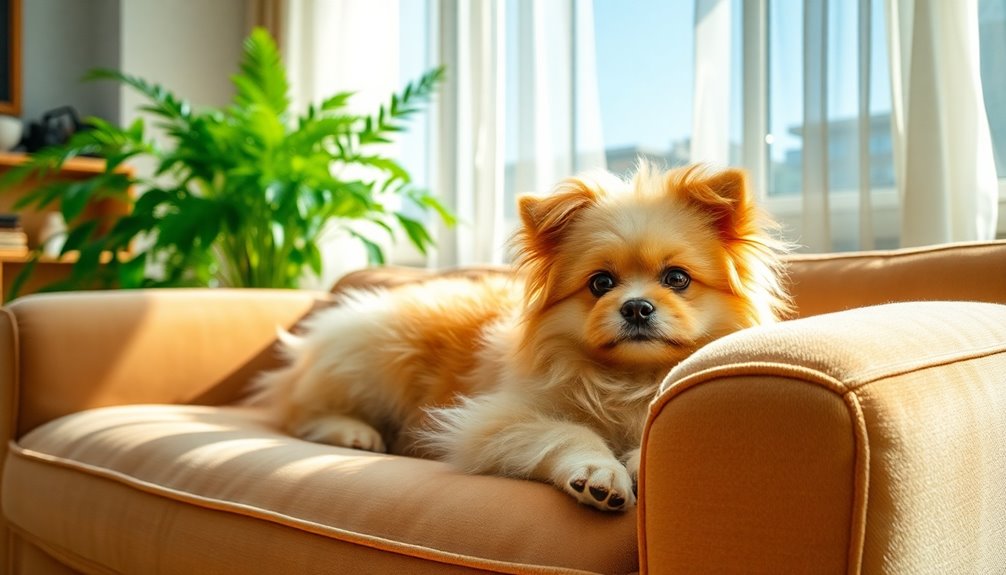
If you live in a cozy apartment, you'll find that a Pekingese and Poodle mix can thrive in that environment. They prefer moderate temperatures, so keeping your home comfortable is key to their well-being. With daily walks, they'll adapt well to your lifestyle, whether you're in the city or the suburbs. These dogs are also known for their intelligent and friendly nature, making them great companions for all family members.
Cozy Apartment Living Preferred
Peekapoos thrive in cozy apartment living due to their small size and adaptable nature. Their compact stature makes them perfect for smaller spaces, and they don't require extensive room to roam. You'll find that a few short walks and some interactive playtime inside your apartment are sufficient to meet their moderate exercise needs. Additionally, they share a similar moderate energy level with Pekingese, making them well-suited for apartment life.
Peekapoos love indoor activities, so engaging them with interactive toys and puzzle games can keep them physically and mentally stimulated. They can also benefit from smart home devices that help monitor their activity levels when you're away.
Grooming is a breeze with Peekapoos, thanks to their low-shedding coat, which is hypoallergenic and minimizes dog hair in your living space. Regular brushing and occasional baths will help maintain their coat's health.
Their affectionate and loyal nature makes them excellent companions, and they thrive on social interactions with you.
While they might bark occasionally, proper training can keep noise levels down, making them suitable for apartment living. Just be mindful of their potential for separation anxiety; they need your company and reassurance.
With a little attention to their needs, you'll find that a Peekapoo fits perfectly into your cozy living environment, bringing joy and companionship to your life.
Prefers Moderate Temperature Ranges
Finding the right living environment for your Peekapoo goes beyond just cozy apartments; it also involves understanding their temperature preferences.
These adorable pups can struggle in hot weather due to their brachycephalic features inherited from their Pekingese parent. To keep them safe, make sure they've access to plenty of shade and water, especially during outdoor activities. Monitor their breathing, as hot conditions can exacerbate respiratory issues. Additionally, due to their health risks, regular veterinary check-ups are critical to ensure they remain in good condition.
On the flip side, Peekapoos handle cold weather better than heat, thanks to their heritage. They thrive in cooler temperatures, making them comfortable in colder climates. You can even keep them in rooms with lower temperatures to ensure their comfort.
When it comes to exercise, adjust their activity level based on the weather. Avoid long outdoor sessions in extreme heat, and consider indoor play during warm spells.
Daily walks and moderate exercise are essential for their health, but always keep an eye on the conditions. By providing a balanced environment, you can keep your Peekapoo happy, healthy, and thriving year-round.
Celebrity Pet of Choice
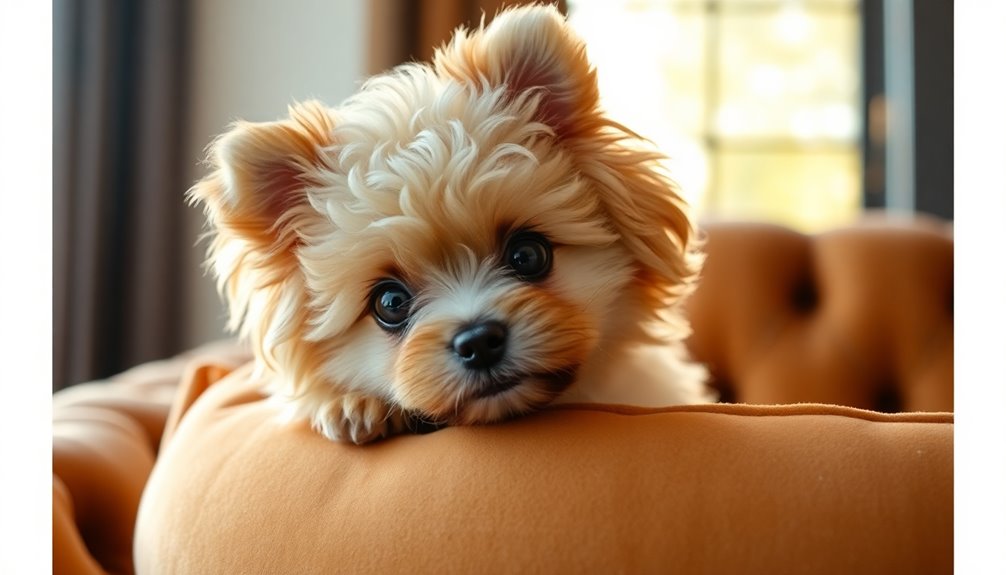
When you think about celebrity pets, Peekapoos often come to mind, especially with their hypoallergenic coats that appeal to many allergy sufferers.
Their unique style and charm can make them Hollywood's canine fashion icons, frequently appearing in trendy outfits on social media. Their loyalty and affection towards their families make them even more desirable companions.
It's no wonder these adorable pups are gaining popularity among pet owners and influencers alike.
Hypoallergenic Coat Traits
Peekapoos can inherit a coat that's wavy, curled, or a combination of both, with a soft texture that can be moderately long if left unclipped. While Poodles are low-shedding, the Pekingese has a double-layered coat that's more prone to shedding. This means that first-generation Peekapoos mightn't be as hypoallergenic due to the potential for inheriting the Pekingese coat. To keep your Peekapoo's coat manageable, daily brushing is essential to prevent knots and tangles, especially if you want to avoid matting. Regular haircuts can help reduce grooming needs and keep their coat in good shape. However, even with the Poodle's single-layered coat traits, Peekapoos may still shed, posing a risk for allergy sufferers. So, if you're considering a Peekapoo, it's crucial to assess their coat characteristics to determine how hypoallergenic they'll be for you and your family. Additionally, the Peekapoo's intelligent nature can make grooming sessions a fun bonding experience for both you and your pet.
Hollywood's Canine Fashion Icon
Peekapoos have carved out a niche for themselves as adorable stars in the world of social media, capturing hearts with their charming looks and playful personalities. While they may not be Hollywood's go-to celebrity pets, their popularity is undeniable.
These little dogs, a delightful blend of Pekingese and Poodle, thrive in the spotlight, especially on platforms like Instagram. Take Coco, for example, who boasts over 48,000 followers and was named Sydney's Top Dog in 2019, and has even popularized dog pawties in Sydney that attract numerous furry guests. Their unique personalities are often showcased through engaging content that resonates with audiences.
With their small size and big personalities, Peekapoos are perfectly suited for showcasing adorable outfits and engaging antics online. Their unique looks and playful demeanor make them ideal for fashion moments, often featured in seasonal attire that delights their fans.
Although they haven't captured the hearts of specific celebrities, their presence in the media is growing through interviews and dog film festivals. Peekapoos have become symbols of canine fashion, making them a favorite among families and individuals who appreciate the affectionate nature of small companion dogs.
Apartment-Friendly Companion?
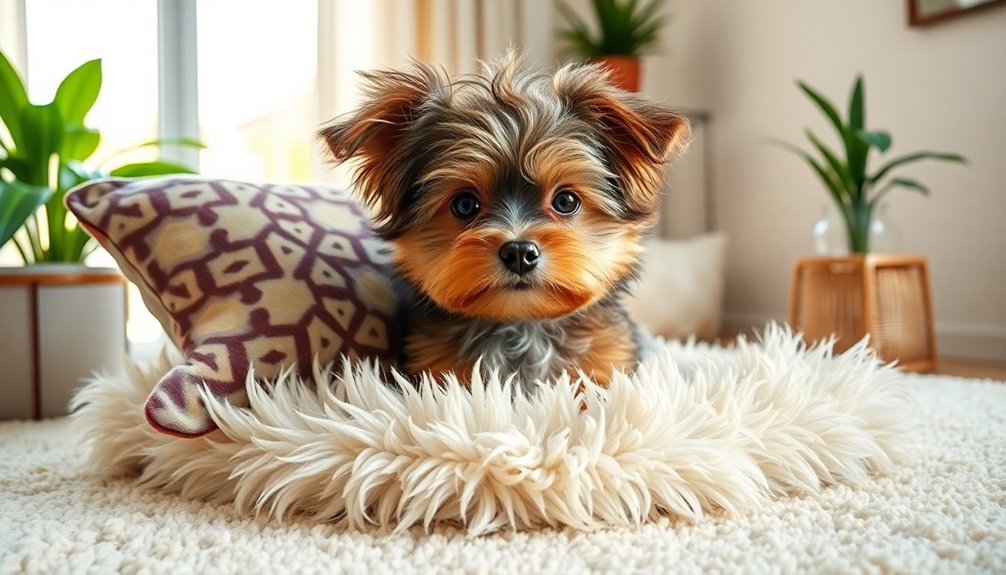
If you're a first-time owner living in an apartment, a Pekingese and Poodle mix could be the perfect companion for you. Their small size and manageable grooming needs make them adaptable to apartment life, while their friendly nature ensures they'll thrive with your interaction. Just remember to provide regular exercise and socialization to keep them happy and well-adjusted in your home. Additionally, incorporating daily walks into their routine is essential for their overall health and well-being.
Ideal for First-Time Owners
For those seeking a cozy companion in an apartment setting, the Pekingese and Poodle mix stands out as an ideal choice. Their small size makes them perfectly suited for smaller living spaces, and their lower activity requirements mean you won't need vast areas for them to thrive. Additionally, as the fall season approaches, seasonal celebrations can provide perfect opportunities to bond with your pup through cozy indoor activities.
Short walks and playful sessions will satisfy their exercise needs, making them manageable for busy lifestyles.
Training these pups is also a breeze, especially if you use positive reinforcement techniques like treats and praise. Short, consistent training sessions work wonders for obedience, while early socialization helps them develop good behavior. Just remember, they do need mental stimulation to avoid boredom, so get creative with interactive toys or gentle games.
If you have kids, this mix generally gets along well, especially with older, well-behaved children. They can be a bit reactive to rowdy antics, so gentle handling is key.
Plus, they're often devoted to their human family members and can coexist happily with other pets when socialized properly.
All in all, this breed is a fantastic option for first-time owners looking for a loyal, loving addition to their home.
Grooming Needs and Maintenance
Maintaining the grooming needs of a Pekingese and Poodle mix is straightforward, making it suitable for apartment living. Depending on whether your Peekapoo inherits a straight or curly coat, you'll need to brush it daily if kept long, or a few times a week if clipped. Regular brushing prevents knots and tangles, keeping their coat healthy. They are known for their low-shedding coats, which makes them suitable for allergy sufferers.
They're generally low-shedding, but you might notice some seasonal shedding. For grooming styles, the popular teddybear cut keeps their fur at a uniform length, which is easy to maintain. When clipping, use electric clippers and follow the hair growth direction to avoid unevenness. A professional groomer can help if your pup is skittish.
Bathing every couple of months is ideal, using a gentle dog shampoo and conditioner. Don't forget to clean their ears and face regularly and trim their nails to prevent overgrowth.
Finally, remember to provide mental stimulation through toys and interaction, ensuring your Peekapoo is happy in an apartment setting. With proper care, you'll have a well-groomed companion that thrives in your home.
Frequently Asked Questions
How Much Exercise Does a Peek-A-Poo Need Daily?
A Peek-A-Poo needs at least 30 minutes of exercise daily to stay healthy and happy.
You can split this time into two walks or mix it with playtime. Adjust the duration based on your dog's age and energy levels.
Puppies may require shorter sessions, while adults can handle longer activities.
Keep an eye on their health, especially in extreme weather, to ensure they don't overexert themselves during exercise.
What Grooming Tools Are Best for a Peek-A-Poo?
When grooming your dog, a slicker brush is your best choice for deshedding and detangling, especially if they've a dense, curly coat.
Pair it with a pin brush for minor touch-ups.
Don't forget a comb to prevent mats and tangles; using a detangler spray can make this easier.
Regular bathing with a mild shampoo and trimming nails every couple of weeks will help keep your furry friend healthy and looking their best.
Can Peek-A-Poos Be Left Alone for Long Periods?
You shouldn't leave Peek-A-Poos alone for long periods. Their inherent clinginess and affectionate nature can lead to separation anxiety.
To help them adjust, start with short alone times and gradually increase the duration. Providing comforting items, like familiar blankets or toys, can ease their anxiety.
Establishing a consistent routine and offering plenty of exercise and mental stimulation will also reduce their stress when you're away, ensuring they remain happy and healthy.
What Is the Average Cost of a Peek-A-Poo?
The average cost of a Peek-A-Poo can range from about $800 to $2,000 when purchased from reputable breeders.
Factors like the breeder's reputation and the puppy's pedigree affect the price.
If you choose to adopt, you'll find fees typically between $150 and $600, which often cover initial veterinary care.
Remember to budget for ongoing expenses, too, which can hit $500 to $1,000 annually after the first year.
Are Peek-A-Poos Good With Children and Other Pets?
If you're considering a dog and have kids or other pets, you'll need to think about the dog's temperament.
Generally, these dogs can be good with older children when socialized early. However, you'll need to supervise interactions to prevent accidental injuries due to their small size.
With other pets, they may be territorial, so early socialization is key. Consistent training will help them adapt better to your home environment.
Conclusion
In summary, the peek-a-poo is an adorable blend of the Pekingese and Poodle, making it an irresistible companion. With its charming personality and manageable size, it's perfect for various living situations, including apartments. By providing proper training and socialization, you'll ensure your peek-a-poo thrives in your home. If you're looking for a loving, intelligent pet that brings joy to your life, you can't go wrong with this delightful little furball!

